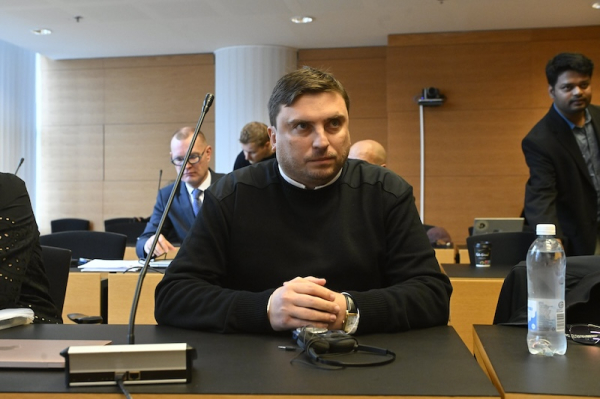Tanker captain denies cable damage was intentional

The Eagle S ship’s captain, Georgian national Davit Vadatchkoria at the District Court in Helsinki, Finland on September 5, 2025. Photo: Mikko Stig / Lehtikuva
- Next Article Finnish law change leaves Palestinian researchers facing expulsion
The captain of the Eagle S tanker has denied all criminal responsibility in a Helsinki court after the vessel damaged five undersea cables while sailing through the Gulf of Finland on Christmas Day 2024.
Davit Vadatchkoria, a Georgian national, faces charges of aggravated criminal damage and serious interference with communications. Prosecutors are seeking at least two-and-a-half years of imprisonment for Vadatchkoria and two senior officers aboard the Cook Islands-flagged vessel.
The tanker allegedly dragged its portside anchor for nearly 90 kilometres, severing key subsea infrastructure including the Estlink 2 power cable and a data cable operated by Finnish telecommunications company Elisa. The anchor was later recovered from the seabed.
According to prosecutors, the anchor’s securing mechanism had deteriorated due to years of neglected maintenance. The equipment meant to hold the anchor in place was reportedly in poor condition and partially broken.
Vadatchkoria acknowledged in court that the anchor was secured using a stopchain and a welded metal bar but claimed no prior problems had occurred. He said any mechanical failure was unexpected and that his crew had inspected the system regularly.
“There were no warning signs. We followed procedures. I don’t know what we could have done differently,” he told the court.
The captain said the anchor’s detachment may have resulted from a failed retaining pin and stop ring, possibly dislodged by vibrations. He claimed that once the incident was suspected, crew were instructed to document the situation without touching any equipment. Photographs were then sent to the ship’s management and later handed over to Finnish police.
In his testimony, Vadatchkoria maintained that the ship’s reduced speed on the day of the incident was believed to stem from a mechanical issue. The engine was shut down to investigate, and the ship resumed its voyage without realising the anchor had dropped.
He admitted the anchor had not been visually confirmed as secured after the stop but argued this was a reasonable human error given the circumstances and fatigue of the crew.
When asked whether anyone on the vessel was instructed to destroy documents, Vadatchkoria denied doing so. He acknowledged the existence of a handwritten internal report sent to the ship’s operator, which was also provided to investigators.
“I did not destroy anything. I gave everything to the police,” he said.
Tensions rose during the hearing when prosecutors questioned inconsistencies in the ship’s logbook. Vadatchkoria admitted that entries were not made in real time, contrary to maritime norms, but argued that safety concerns took precedence over paperwork.
“I have a duty to document, but my primary responsibility is the safety of the vessel and the crew,” he said. “Most accidents at sea happen because people focus on documentation instead of navigation.”
At times, the court intervened as Vadatchkoria’s answers became lengthy and emotional. He criticised the conduct of Finnish authorities, claiming the vessel was seized in what he called a “military-style operation”. He said the Finnish Coast Guard ordered him into Finnish waters, a claim that has not been confirmed by officials.
“I obeyed their command without hesitation. I didn’t even think about the territorial boundary,” he said.
Asked whether he was aware of past anchor drops on other vessels owned by the same operator, Vadatchkoria said he was not, but added, “There are many such incidents in the industry, though they are rarely discussed publicly.”
During a separate police interview, Vadatchkoria conceded that if it is confirmed the anchor dragged across the seabed, he had no alternative explanation for the ship’s behaviour.
“If that is proven, then I cannot deny it,” he said. “But based on the speed and navigation data at the time, we saw nothing abnormal.”
The Finnish Transport and Communications Agency later confirmed that the ship’s anchor path crossed several known cable routes. Finnish authorities detained the vessel on 26 December and conducted a detailed inspection at the port of Porvoo before releasing it in March.
Prosecutors have not drawn conclusions about the ship’s possible connection to so-called “shadow fleet” operations linked to Russia. They declined to comment on whether the incident was intentional or related to broader hybrid threats.
The case has attracted national attention in Finland due to its impact on energy and communications infrastructure and its timing amid heightened security concerns in the Baltic Sea region.
The main trial will continue next week. A verdict is expected later in the year.
HT
- Next Article Finnish law change leaves Palestinian researchers facing expulsion
Source: www.helsinkitimes.fi
